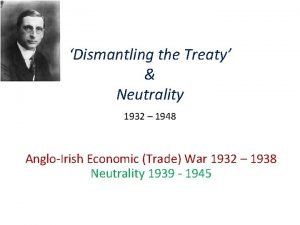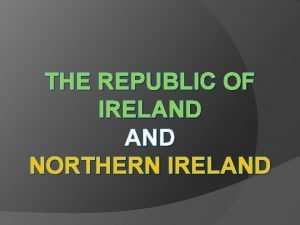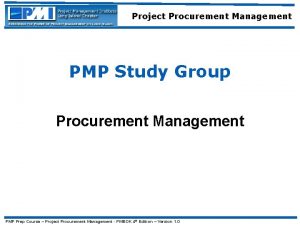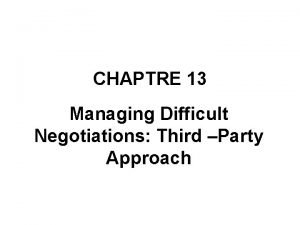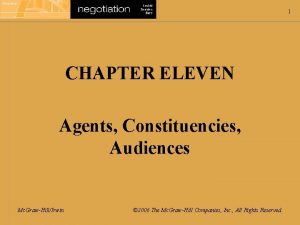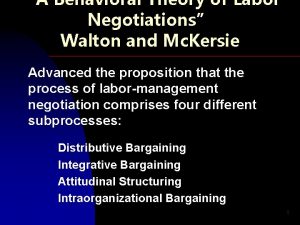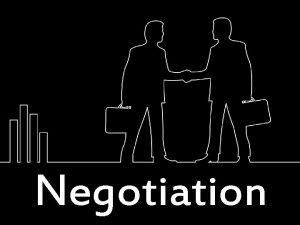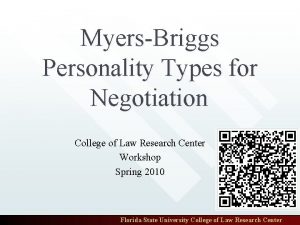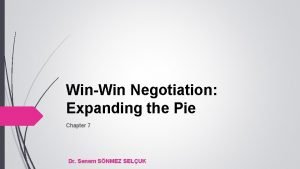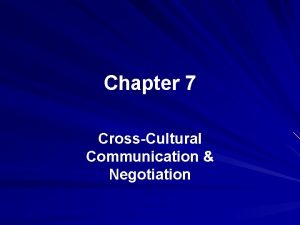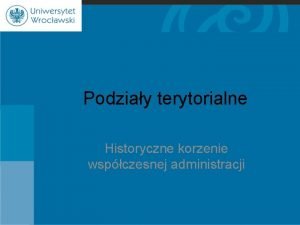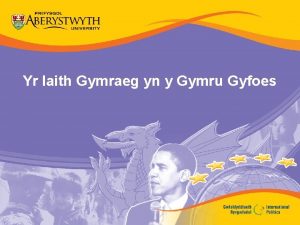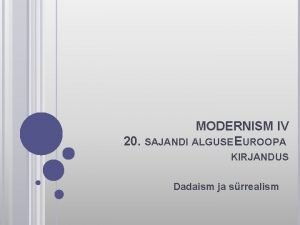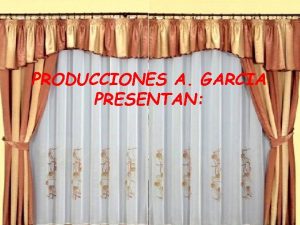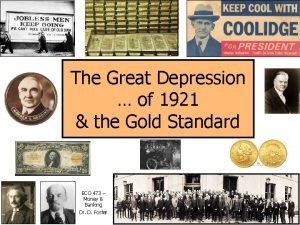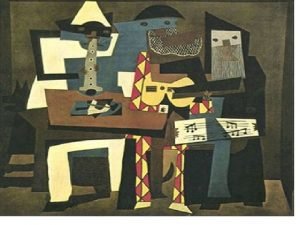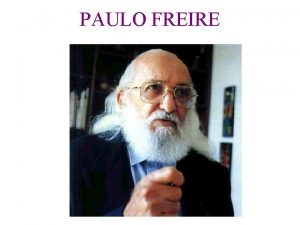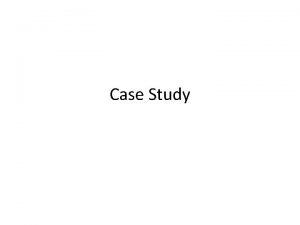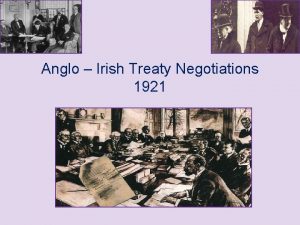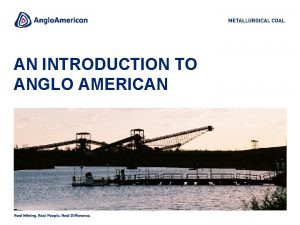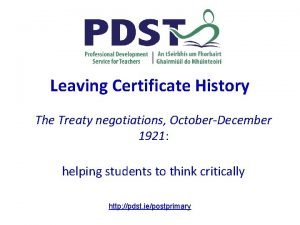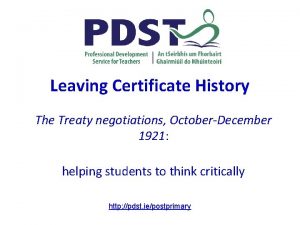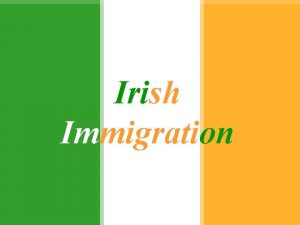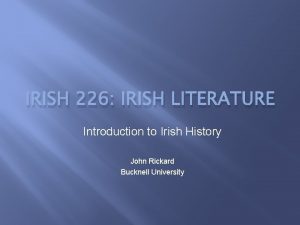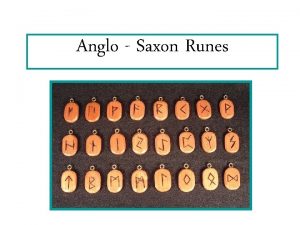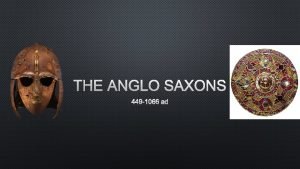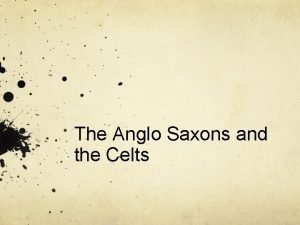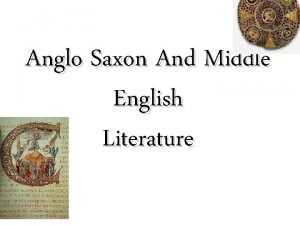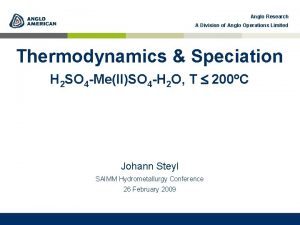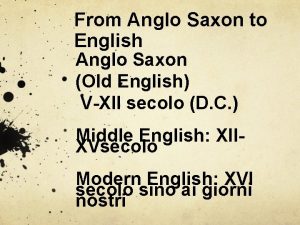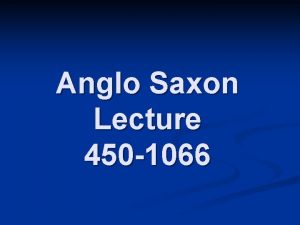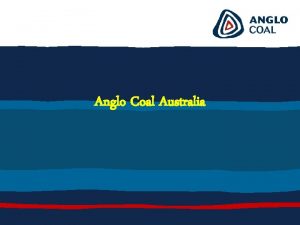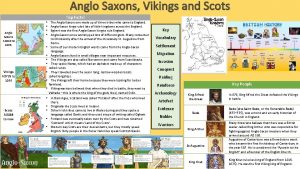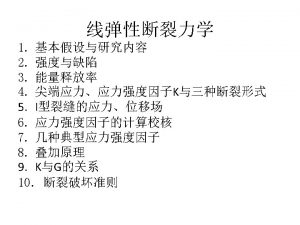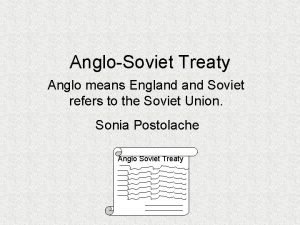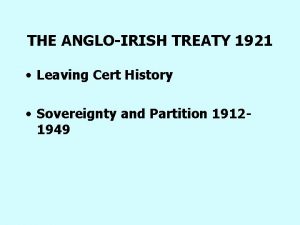Anglo Irish Treaty Negotiations 1921 Part I Preliminary


























- Slides: 26

Anglo – Irish Treaty Negotiations 1921

Part I: Preliminary Discussions (July – October 1921) Part II: Delegations & Negotiations in London (October – December 1921) Part III: Dáil Debates & Vote on Treaty (December 1921 – January 1922)

The Leaders Dáil Eireann British Government

Part I: Preliminary Discussions De. Valera & Lloyd George (July – October 1921)

Background to Negotiations • Escalating political and social unrest in Ireland throughout 1920 & 1921: British Government losing control of Ireland, politically & militarily • Truce and offer of negotiations made by British Government in July 1921 • Truce comes into effect on 11 th July, 1921 • Between July & October 1921, De. Valera & Lloyd George meet and correspond with each other in an attempt to resolve key issues between British Government & Sinn Féin.

De. Valera’s Talks with L. George (1920) In 1920, De. Valera held a series of discussions with Lloyd George about a possible settlement even while the War of Independence was raging throughout the country. The most persistent idea that de. Valera espoused was that of ‘External Association’, whereby an independent Ireland would be choose to be ‘externally associated’ with Britain: thereby accommodating Unionists in the north of Ireland


Key Issues Sovereignty • The Proclamation of the Irish Republic (1916) and the Declaration of Independence (1919) were the Republican movement’s key manifestos. • In these, Republicans committed themselves to a fully-sovereign, independent, united Ireland Partition • The Government of Ireland Act (1920) remained Britain’s final compromise towards the situation in Ireland. • In this provision, Ireland would be divided, north & south, to protect Unionist membership of the UK and keep all of Ireland within the British Empire

‘External Association’ • De. Valera’s key concept which envisaged an independent, united Ireland, ‘externally associated’ to Britain. • This external association was conceived as an attempt to placate Unionists’ fears of an Catholic-dominated, independent Ireland.

Choosing a Delegation: Controversy & Confusion De. Valera’s decision to remain in Dublin: How would External Association be argued convincingly if its author was not present? De. Valera’s qualification of ‘Envoys Plenipotentiaries’: ‘a main question’ or ‘the complete text of the draft treaty about to be signed’ (Refer back to Dublin) To what extent did this secret instruction diminish the Sinn Féin delegation’s ability to achieve their objectives in negotiation?

Prelude to Negotiations Instructions to Irish Delegation British Proposals & Representatives ‘Draft Treaty A’ = External Association Northern Ireland already established: therefore ‘off the table’ De. Valera’s qualification of ‘Envoys Plenipotentiaries’: Integrity of British Commonwealth to be maintained Lloyd George, Winston Churchill, Chamberlain & Lord Birkenhead to form front-line negotiation team. ‘a main question’ or ‘the complete text of the draft treaty about to be signed’ (Refer back to Dublin) De. Valera’s insistence at remaining at home during negotiations. (To distance the office of President of Dáil Eireann from unacceptable proposals & create time-lapse to control direction of negotiations)

Government of Ireland Act (1920) - In response to the escalating situation throughout most of the country, northern Unionists moved to cement their position within the United Kingdom. - The result of these talks between Craig & Lloyd George was the Government of Ireland Act (1920), whereby the north of Ireland would remain part of the UK as long they wished. - When the Anglo-Irish Treaty was signed, one of the key agreements was that the north of Ireland could ‘opt out’ of the new Irish Free State if they wished. They did so, two days after the foundation of the Irish Free State on December 8 th, 1921.

` Government of Ireland Act (1920) • • • Lloyd George hoped to bring about a ‘Home Rule all Round’ solution to Ireland, thereby placating both Republicans & Unionists as well as international opinion. Unionists demanded simple majority, but PR was inserted into the Bill as the voting method. Unionists argued in favour of a 6 county Northern Ireland, rather than a 9 -county Northern Ireland, thereby ensuring their majority in the new state. Provisions of the Act: - - A ‘Northern State’ of six counties & a ‘Southern State’ of 26 counties Bicameral Parliaments, North & South (Commons & Senate) Each State would elect a government & a Prime Minister Both states would share a common Viceroy to the King of England Westminster would retain ‘Imperial Powers’ over both states A ‘Council of Ireland’ would be set up to create a platform for discussion, interaction & agreement between both states.

Negotiations Begin October 11 th – December 6 th 1921

Anglo – Irish Treaty Negotiations 1921 Sinn Féin Delegation British Delegation Arthur Griffith, Michael Collins, Robert Barton, George Gavin Duffy, Eamon Duggan , Erskine Childers. Lloyd George, Winston Churchill, Lord Birkenhead , Austen Chamberlain

Issues of Contention Offer of negotiation from British Government to Dáil Eireann in July 1921. Truce declared on July 11 th 1921. Plenipotentiaries: Who should negotiate & what powers should they be granted? “. . negotiate and conclude … a treaty or treaties of settlement, association and accommodation between Ireland the community of nations known as the British Commonwealth. . ” ‘Dominion Status’ v. ‘External Association’ : What was the ultimate aim of the Sinn Féin delegation? Partition, Unionism & Government of Ireland Act (1920): How would the Sinn Féin delegation overcome the already-established Northern Ireland State?

Sinn Féin Delegation • • • Passionate but inexperienced Removed from support of Dáil Éireann & Dáil Cabinet Made up of moderates & extremists

British Delegation

Negotiations: 11 th October – 6 th December 1921 11 th – 17 th October: British delegation outline strong proposals and reinforce their aim to maintain the integrity of British Commonwealth. Sinn Féin delegation refute British claim over Ireland & offer considered clarifications & responses. Little progress made. 24 th October: Griffith & Collins present the first draft of Irish proposals. ‘Republic’ is not used in this draft, and discussions focus primarily on issue of defense. 2 nd November: Griffith accepts, in principle, Ireland’s membership of the British Commonwealth: ‘to recommend recognition of the crown’ in return for “essential unity” of the Irish nation. Writes a note to Lloyd George to underline this before the British PM meets Ulster Unionists. New draft of letter on 2 nd November declares that Ireland will join the Commonwealth and recognise the King “as head of the proposed Association of Free States”

Negotiations: 11 th October – 6 th December 1921 2 nd – 8 th November: Griffith & Collins continue to struggle with ‘External Association’ concept, with the previous discussions and notes having moved the position more towards ‘Dominion Status’. 8 th November: Tom Jones, Lloyd George’s secretary proposed the setting up of a ‘Boundary Commission’ to look at the border between a future Irish State (26 counties) & Northern Ireland (established by Govt. of Ireland Act 1920) 12 th November: 22 nd November:

Negotiations: 11 th October – 6 th December 1921 Final Proposals: December 1 st – 5 th: December 6 th:

Anglo-Irish Treaty 1921

Dáil Debates & Vote on Treaty December 8 th 1921 – January 7 th 1922

Dáil Debates Anglo-Irish Treaty M. Collins (Pro-Treaty) E. de. Valera (Anti-Treaty) • Freedom to achieve freedom • Control of Internal Affairs • Removal of British forces from Ireland • Oath of Allegiance • Partition • Dominion Status

Dáil Vote on Anglo-Irish Treaty 7 th January 1922 Republican Ideal Oath of Allegiance unacceptable Partition unacceptable Irish Free State: “freedom to achieve freedom” Boundary Commission to examine Partition Border

 Angloirish
Angloirish Anglo irish flag
Anglo irish flag Pet reading part 6 2020
Pet reading part 6 2020 Procurements
Procurements Managing difficult negotiations
Managing difficult negotiations How agents, constituents and audiences change negotiations?
How agents, constituents and audiences change negotiations? Procurement negotiations pmp
Procurement negotiations pmp A behavioral theory of labor negotiations
A behavioral theory of labor negotiations What are the objectives of negotiation
What are the objectives of negotiation Types of negotiations
Types of negotiations Expanding the pie in negotiation
Expanding the pie in negotiation Cross cultural communication in business negotiations
Cross cultural communication in business negotiations Cisco 1921 スループット
Cisco 1921 スループット What is the red scare
What is the red scare 17 marca 1921
17 marca 1921 Poblogaeth cymru 1891
Poblogaeth cymru 1891 Kirjandusrühmitus tarapita
Kirjandusrühmitus tarapita Nowele sierpniowe
Nowele sierpniowe Site:slidetodoc.com
Site:slidetodoc.com Annual
Annual 1921 gold standard
1921 gold standard The three musicians
The three musicians Cisco 1921 throughput
Cisco 1921 throughput Paulo freire nasceu em recife em 1921
Paulo freire nasceu em recife em 1921 Image of development
Image of development Dodero company produces a single product
Dodero company produces a single product Preliminary outline speech
Preliminary outline speech
